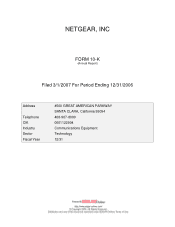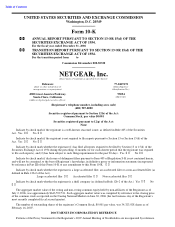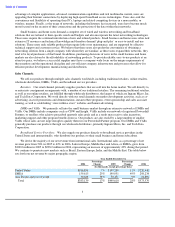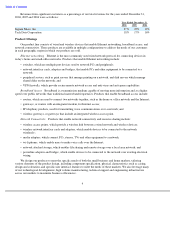Netgear 2006 Annual Report Download - page 9
Download and view the complete annual report
Please find page 9 of the 2006 Netgear annual report below. You can navigate through the pages in the report by either clicking on the pages listed below, or by using the keyword search tool below to find specific information within the annual report.
Table of Contents
Our products that target the small business market are designed with an industrial appearance, including metal
cases, and for some product categories, the ability to mount the product within standard data networking racks. These
products typically include higher port counts, higher data transfer rates and other performance characteristics
designed to meet the needs of a small business user. For example, we offer data transfer rates up to ten Gigabit per
second for our business products to meet the higher capacity requirements of business users. Some of these products
are also designed to support transmission modes such as fiber optic cabling, which is common in more sophisticated
business environments. Security requirements within our products for small business broadband access include
firewall and virtual private network capabilities that allow for secure interactions between remote offices and
business headquarter locations. Our connectivity product offerings for the small business market include enhanced
security and remote configurability often required in a business setting.
Our products for the home user are designed with pleasing visual and physical aesthetics that are more desirable
in a home environment. For example, our RangeMax series of routers have distinctive blue antenna-indicator LEDs
in a circular dome atop a sleek white plastic casing. Our connectivity offerings for use in the home are generally at a
lower price than higher security and configurability wireless offerings for the small business market. Our products
for facilitating broadband access in the home are available with features such as parental control capabilities and
firewall security, to allow for safer, more controlled Internet usage in families with children. Our broadband products
designed for the home market also contain advanced installation software that guides a less sophisticated data
networking user through the installation process with their broadband service provider, using a graphical user
interface and simple point and click operations. Our connectivity product offerings for the home include powerline
data transmission modes which allow home users to take advantage of their existing electrical wiring infrastructure
for transmitting data among network components.
Competition
The small business and home networking markets are intensely competitive and subject to rapid technological
change. We expect competition to continue to intensify. Our principal competitors include:
Other current competitors include numerous local vendors such as Siemens Corporation and AVM in Europe,
Corega International SA and Melco, Inc./Buffalo Technology in Japan and TP-Link in China, and broadband
equipment suppliers such as ARRIS Group, Inc., Motorola, Inc., Sagem Corporation, Scientific Atlanta, a Cisco
company, Terayon Communications Systems, Inc., Thomson Corporation and 2Wire, Inc. Our potential competitors
include consumer electronics vendors and telecommunications equipment vendors who could integrate networking
capabilities into their line of products, and our channel customers who may decide to offer self-branded networking
products. We also face competition from service providers who may bundle a free networking device with their
broadband service offering, which would reduce our sales if we are not the supplier of choice to those service
providers.
Many of our existing and potential competitors have longer operating histories, greater name recognition and
substantially greater financial, technical, sales, marketing and other resources. As a result, they may have more
advanced technology, larger distribution channels, stronger brand names, better customer service and access to more
customers than we do. For example, Dell Computer has significant brand name recognition and has an advertising
presence substantially greater than ours. Similarly, Cisco Systems is well recognized as a leader in providing
networking solutions to businesses and has substantially greater financial resources than we do. Several of our
competitors, such as the Linksys division of Cisco Systems and D-Link, offer a range of products that directly
compete with most of our product offerings. Several of our other competitors primarily compete in a more limited
manner. For example, Hewlett-Packard sells networking products primarily targeted at larger businesses or
enterprises. However, the competitive environment in which we operate changes rapidly. Other large companies with
significant resources could become direct competitors, either through acquiring a competitor or through internal
efforts.
5
• within the small business networking market, companies such as 3Com, Allied Telesyn, the Linksys division
of Cisco Systems, Dell Computer, D
-
Link, Hewlett
-
Packard, Nortel Networks, and SonicWall, Inc.; and
• within the home networking market, companies such as Belkin Corporation, D-Link, and the Linksys division
of Cisco Systems.






















